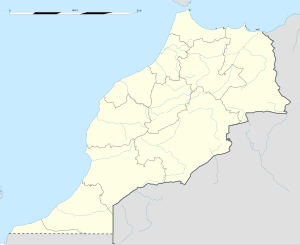Tafilalt
|
Tafilalt Tafilalt / ⵜⴰⴼⵉⵍⴰⵍⵜ |
|
|---|---|
| Region | |

Panorama of the oasis of Tafilalet, seen from the ksar of Tingheras (Rissani).
|
|
| Location in Morocco | |
| Coordinates: 31°20′22.43″N 4°16′5.48″W / 31.3395639°N 4.2681889°WCoordinates: 31°20′22.43″N 4°16′5.48″W / 31.3395639°N 4.2681889°W | |
| Country |
|
| Region | Drâa-Tafilalet |
| Time zone | WET (UTC+0) |
| • Summer (DST) | WEST (UTC+1) |
Tafilalt or Tafilet (Berber: Tafilalt, ⵜⴰⴼⵉⵍⴰⵍⵜ; Arabic: تافيلالت), historically Sijilmasa, is a region and the largest oasis in Morocco.
The word "Tafilalt" is an Amazigh word and it means "Jug", which is specifically a jar made of clay and used to conserve water.
In the area, the town of Sijilmasa founded by Miknasa Amazigh leader Moussa ben Nasser in 757, formerly existed. It was on the direct caravan route from the Niger river to Tangier, and attained a considerable degree of prosperity. In the 17th century, the Alaouite dynasty of Morocco is known to have started in Tafilalt, and in 1606 Zidan al-Nasir, Sultan of Morocco hid in Tafilalt, where he made a profit off of gold mined in the area, built an army, and took back control over Marrakech. A few years later in 1610, Ahmed ibn Abi Mahalli also built up in army in the Tafilalt area and took Marrakech back for himself, but lost control after Sidi Yahya ben Younes liberated the city for al-Nasir. A decade after this, a small revolt built up in Tafilalt against the sultan, but was repressed after four months of skirmishes. Later, Tafilalt was a major center of the Dila'ites. In 1648, a custom was established of the Moorish sultans of Morocco sending superfluous sons or daughters to Tafilalt.
Medieval traveler Ibn Batuta wrote about visiting Sijilmasa (near Tafilalt) in the fourteenth century on his journey from Fez to Mali, "the country of the blacks". It was later destroyed in 1818 by the Aït Atta, but its ruins remain, including two gateways. The first European to visit Tafilalt in the modern era was René Caillié (1828), and later Gerhard Rohlfs (1864). English writer WB Harris described Tafilalt in a journal after his visit.
...
Wikipedia

